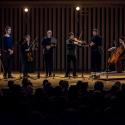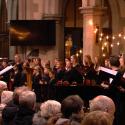Is there something about the start of a new cultural season, or indeed the Proms, that make classical music’s conductors rush to jump ship? Consider this. Last Friday, two days before his pair of Prom concerts with his American outfit, the Cleveland Orchestra, Franz Welser-Möst, so diffident on the outside, resigned from his important European post as the Vienna State Opera’s music director with immediate effect. Irreconcilable artistic differences were cited.
Then on Monday morning, the day after fronting the patchily effective Proms debut of Qatar’s multi-national, peace-loving trophy orchestra, the Qatar Philharmonic, conductor and cellist Han-Na Chang resigned as that orchestra’s music director, again with immediate effect. So that’s why they didn't include an encore! And the reasons cited for her departure? “Irreconcilable artistic differences”, the very same phrase, topped off with administrative problems.
Now, temperaments and principles readily get bashed in the hothouse opera world, and problems can easily be imagined for a woman working for a fledgling orchestra in a highly conservative Emirate state with cultural reputations (and a dodgy record over migrant labour). Even so, the Cleveland musicians, an excellent bunch, might have been quivering just a bit as their second Prom last night approached. Would Welser-Möst, the wind gusting in his sails, now get divorced from them as well? No sign of that so far: he’s been at the job now for 12 settled years and his current contract runs to 2018.
The overriding missing ingredient? Raging passion, you could call it, or some kind of personal vision
Mind you, as I settled back on Sunday and Monday into the comfy armchair of Welser-Möst’s Brahms, there were times when irreconcilable artistic differences could have been just what the performances needed. On Sunday, in Brahms’ First Symphony, Welser-Möst and the Cleveland players, joined at the hip, had offered playing divinely precise, exquisitely refined. They had also in the process de-fanged at least some of the symphony’s glowering drama. Last night’s offering, the more lyrical and autumnal Second Symphony, gave them less scope for weakening the music’s power, though it was still striking what faint mark any passages of tension made.
Not that the music-making’s gleaming surface on Monday could ever derail all pleasure. In the first movement I was content enough being pulled along by most of Brahms’ argument, carefully finessed by Welser-Möst’s hands. In the finale, we had the symphony’s final victory parade, genuinely rousing, and ravishing passages so silky and quiet that if the Albert Hall’s mice had ever squeaked I’m sure we would have heard them. Throughout, as in the opening Tragic Overture, the orchestra’s solid virtues were unmistakable: clarity of line, perfect balance, clockwork precision, and the kind of woodwind and brass timbres people only expect to hear in heaven. And the overriding missing ingredient? Raging passion, you could call it, or some kind of personal vision – something at any rate that might move us beyond the topiary perfection that seems part of the Clevelanders’ DNA.

A “symphonic hymn”, Widmann called it; though I don’t see how hymns could be sung to the score’s astonishing jostle of extremely low burblings, dangling flutes, jabbing percussion, slashing chords, and figurations spun into textures mindful of the Rosenkavalier Strauss and early Schoenberg only to be cut off in their romantic prime. In an interview in the programme booklet, Welser-Möst voiced his suspicion that the piece, alternately stormy and sweet, contained “a lot of Widmann’s personal life”. What a life!
Still it held the interest, just about, and certainly showed that the Cleveland Orchestra can patrol contemporary music’s barricades with terrific expertise, commitment and flair. But will the world’s conductors hold the line after this turbulent weekend? Celebrity deaths, after all, always seem to come in threes; maybe musical resignations do too.














Add comment